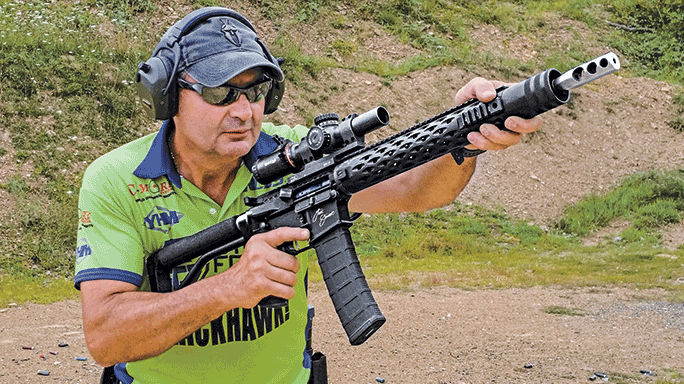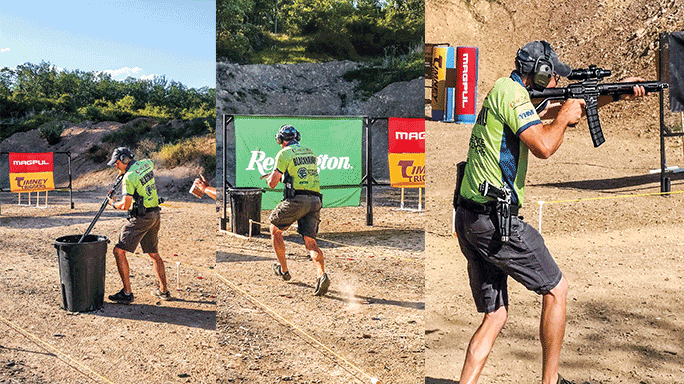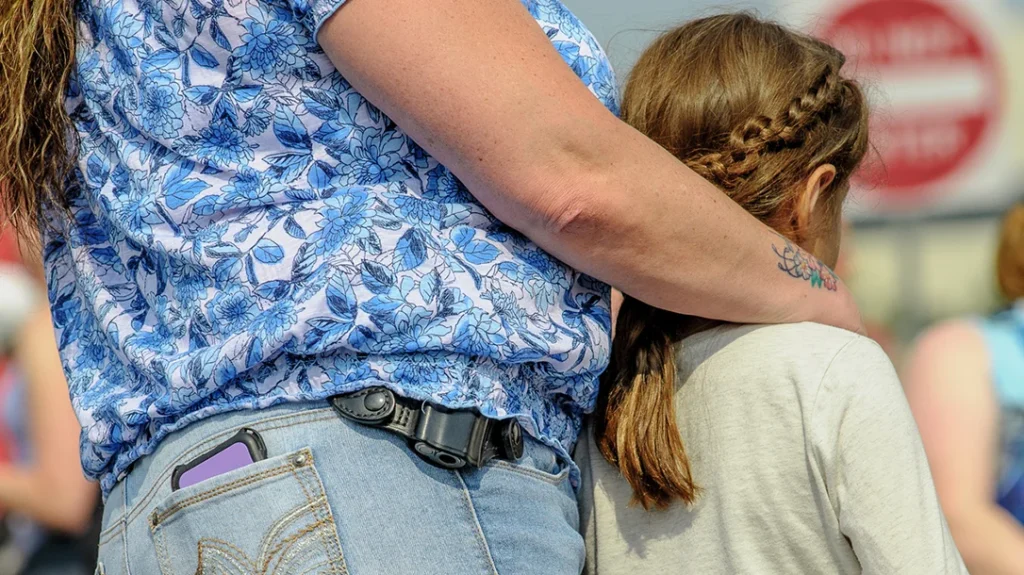Todd Jarrett has been a top shooting competitor for decades, winning an impressive number of national and international shooting titles, including USPSA Open National Champion multiple times and IPSC World Champion. He conducts classes on competitive shooting but also teaches law enforcement and elite military units to shoot faster and more accurately. We were able to interrupt his busy schedule long enough to ask him a few questions.
- RELATED STORY: Rob Leatham: How to Shoot to Win
Special Weapons: What is your background, and how long have you been shooting competitively?
Todd Jarrett: I’ve been in this business for 32 years and started shooting competitively in 1983. I’m not currently working with a gun company because I want to shoot the gun that I want to shoot instead of just one company’s gun. I’ve either worked or am working for Para Ordnance, Safariland, BlackHawk, Hornady or Federal. And I’ve been consulting and teaching for the last 20 years.
Advertisement — Continue Reading Below
SW: Do you have a military or law enforcement background?
TJ: No, but I’ve shot over 3 million rounds in my career. So I tell my students that I teach shooting, weapons manipulation and speed, but not tactics. And many individuals I’ve taught have said to me, “Todd, that technique you showed me saved my life.” It’s a great feeling for me.
SW: What tips or tricks do you teach your students about trigger control?
Advertisement — Continue Reading Below
TJ: Good question. It is the number one thing I teach my classes. There is a wide range of how people teach trigger control. I have not relied on the trigger reset since my early days of shooting, and there are a couple of other top competitors like myself who do not teach using the trigger’s reset. And the reason is, if you have to shoot another firearm, you may not know where the reset point is. I teach my students so they can shoot an AK, a Makarov, a Glock or whatever other gun they may have to use.
SW: What do you tell them about sight picture?
TJ: We’re talking iron sights here. There are times when you need a perfect sight picture and there are times when you don’t. It depends on lighting conditions. At 3 to 5 yards, you may be able to use your whole firearm as the sight. But once you exceed 7 yards with a handgun, you will need to use the front sight to engage a target properly.
Advertisement — Continue Reading Below
SW: What do you tell students about holding and gripping the gun?
TJ: I advocate using a very strong grip on the gun, and most of the top competitive pistol shooters in the country have an extremely tight grip. You need it for high-speed shooting. I actually hold my gun tighter with my support hand—it’s probably 60/40.
SW: What about stance?
Advertisement — Continue Reading Below
TJ: I would say that 50 percent of missed shots by law enforcement are because the shooter doesn’t post up correctly on target. If you don’t have your body squared up correctly to the target, you’re not going to be able to get hits at high speed. This applies to handguns, rifles and shotguns.
SW: How important is speed, and what do you tell your students about developing it?
TJ: Speed comes from Mother Nature, but I have students try to speed up. First, I’ll have the student shoot as fast as they possibly can while maintaining safe control. I don’t care if they score good hits as long as they’re safe. And then I have them back off 20 percent to find a happy medium between speed and accuracy.
Advertisement — Continue Reading Below
SW: How do you instruct students to transition from target to target faster?
TJ: As I transition to the next target, I want my eyes to find a small spot on that target and then bring the gun to it. If you are following your sights to the next target, you are going to double your acquisition time.
SW: What is the longest range you have students shoot a pistol?
Advertisement — Continue Reading Below
TJ: One hundred yards away. In the famous Hollywood shootout, most officers were 50 to 100 yards away from the criminals. Only three officers engaged, and they were about 68 yards away. The other officers didn’t shoot because they didn’t know where their bullets would impact since they had never shot at more than 25 yards. So I want my students to be able to hit a man-sized target 50 percent of the time at 100 yards.
- RELATED STORY: 8 Experts Pick Their Home Defense Weapon of Choice
SW: Since you brought up the Hollywood shootout, what do you tell students about moving while shooting?
TJ: Most of my students will be able to engage a target on the move at 25 yards away. I tell them to let the sights dictate when you fire, because if you’re concentrating on your feet, you’re not going to be able to hit the target.
Advertisement — Continue Reading Below
SW: How often should a student practice and hone their shooting fundamentals, and how many rounds should they fire in a session?
TJ: I know most of my students won’t be able to shoot once a week, so I tell them to dry fire twice a week for 20 minutes and practice draws, moving, posting up, using barricades and acquiring sight pictures at different distances. I advocate getting into some form of competition because it gives them practice in weapons manipulation under stressful situations and puts them on the clock.

























